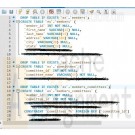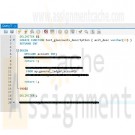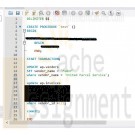Search results for '''
-

DAT/305 Week 3 Challenge Activities 3.5.1: Deque ADT
Regular Price: $5.00
Special Price $3.00
DAT/305 Week 3 Challenge Activities 3.5.1: Deque ADT
CHALLENGE ACTIVITY 1
Given an empty deque numDeque, what are the deque's contents after the following operations?
PushBack(numDeque, 24)
PushFront(numDeque, 49)
PushBack(numDeque, 44)After the above operations, what does PeekFront(numDeque) return?
After the above operations, what does PeekBack(numDeque) return?
After the above operations, what does GetLength(numDeque) return?
CHALLENGE ACTIVITY 2Given an empty deque numDeque, what are the deque's contents after the following operations?
PushBack(numDeque, 95)
PopFront(numDeque)
PushFront(numDeque, 42)
PushFront(numDeque, 25)
PopBack(numDeque)After the above operations, what does GetLength(numDeque) return?
CHALLENGE ACTIVITY 3Given numDeque: 19, 38
PeekFront(numDeque)
PopFront(numDeque)
After the above operations, what does GetLength(numDeque) return?After the above operations, what does IsEmpty(numDeque) return?
Learn More -

DAT/305 Week 3 Challenge Activities 3.3.1: Queue ADT
Regular Price: $5.00
Special Price $4.00
DAT/305 Week 3 Challenge Activities 3.3.1: Queue ADT
CHALLENGE ACTIVITY 1
Given numQueue: 75, 45
What are the queue's contents after the following operations?
Enqueue (numQueue, 80)
Dequeue(numQueue)After the above operations, what does GetLength(numQueue) return?
CHALLENGE ACTIVITY 2Given numQueue: 90, 60
What does Peek(numQueue) return?What is the queue after the following operations?
Peek(numQueue)
Dequeue (numQueue)
Peek(numQueue)
Enqueue (numQueue, 90)After the above operations, what does GetLength(numqueue) return?
CHALLENGE ACTIVITY 3Given numQueue: 73, 39
Peek(numQueue)
Dequeue (numqueue)
After the above operations, what does GetLength(numQueue) return?After the above operations, what does IsEmpty(numQueue) return?
CHALLENGE ACTIVITY 4Given numQueue is empty, what does the list head pointer point to?
What does the list tail pointer point to?
After the following operations:
Enqueue (numQueue, 26)
Enqueue (numQueue, 47)
Enqueue (numQueue, 22)
Dequeue (numQueue)What does the list head pointer point to?
What does the list tail pointer point to?
Learn More -

DAT/305 Week 3 Challenge Activities 3.2.1: Stacks using linked lists
Regular Price: $5.00
Special Price $3.00
DAT/305 Week 3 Challenge Activities 3.2.1: Stacks using linked lists
CHALLENGE ACTIVITY 1
Given an empty stack numStack, what does the list head pointer point to? If the pointer is null, enter null.
After the following operation, which node does the list head pointer point to?
StackPush(numStack, 83)
CHALLENGE ACTIVITY 2Given numStack: 54, 38, 25, 28 (top is 54)
After the following operation: StackPush(numStack, 40)
What node does newNode's next pointer point to? If the pointer is null, enter null.What node does the list's head pointer point to?
CHALLENGE ACTIVITY 3Given numStack: 51 (top is 51)
After the following operation: StackPop(numStack)
What is returned?What node does the list's head pointer point to? If the pointer is null, enter null:
Learn More -

DAT/380 Week 5 LAB 5.6 - Implement independent entity (Sakila)
Regular Price: $5.00
Special Price $3.00
DAT/380 Week 5 LAB 5.6 - Implement independent entity (Sakila)
Implement a new independent entity phone in the Sakila database. Attributes and relationships are shown in the following diagram:
The phone entity appears on the right. The phone entity contains four attributes, each followed by cardinality information: phone_id 1-1(1), country_code M-1(1), phone_numer M-1(1), and phone_type M-1(0). Three entities appear on the left: store, staff, and customer, connected to the phone entity by three identical relationships. The three relationships are named 'has' and have cardinality 1(0) on both sides.
The diagram uses Sakila naming conventions. Follow the Sakila conventions for your table and column names:
All lower case
Underscore separator between root and suffix
Foreign keys have the same name as referenced primary keyWrite CREATE TABLE and ALTER TABLE statements that:
1. Implement the entity as a new phone table.
2. Implement the has relationships as foreign keys in the Sakila customer, staff, and store tables.
3. Remove the existing phone column from the Sakila address table.Step 2 requires adding a foreign key constraint to an existing table. Ex:
ALTER TABLE customer
ADD FOREIGN KEY (phone_id) REFERENCES phone(phone_id)
ON DELETE SET NULL
ON UPDATE CASCADE;
Specify data types as follows:
phone_id, phone_number, and country_code have data type INT.
phone_type has date type VARCHAR(12) and contains strings like 'Home', 'Mobile', and 'Other'.Apply these constraints:
Learn More
NOT NULL constraints correspond to cardinalities on the diagram above.
Foreign key actions are SET NULL for delete rules and CASCADE for update rules.
Specify a suitable column as the phone table primary key. -

DAT/380 Week 4 LAB 4.6 - Select lesson schedule with inner join
Regular Price: $5.00
Special Price $3.00
DAT/380 Week 4 LAB 4.6 - Select lesson schedule with inner join
The database has three tables for tracking horse-riding lessons:
Horse with columns:
ID - primary key
RegisteredName
Breed
Height
BirthDateStudent with columns:
ID - primary key
FirstName
LastName
Street
City
State
Zip
Phone
EmailAddressLessonSchedule with columns:
HorseID - partial primary key, foreign key references Horse(ID)
StudentID - foreign key references Student(ID)
LessonDateTime - partial primary keyWrite a SELECT statement to create a lesson schedule with the lesson date/time, horse ID, and the student's first and last names. Order the results in ascending order by lesson date/time, then by horse ID. Unassigned lesson times (student ID is NULL) should not appear in the schedule.
Hint: Perform a join on the Student and LessonSchedule tables, matching the student IDs.
Learn More -

DAT/380 Week 3 LAB 3.10 - Create Horse table with constraints
Regular Price: $5.00
Special Price $3.00
DAT/380 Week 3 LAB 3.10 - Create Horse table with constraints
Create a Horse table with the following columns, data types, and constraints. NULL is allowed unless 'not NULL' is explicitly stated.
ID - integer with range 0 to 65 thousand, auto increment, primary key
RegisteredName - variable-length string with max 15 chars, not NULL
Breed - variable-length string with max 20 chars, must be one of the following: Egyptian Arab, Holsteiner, Quarter Horse, Paint, Saddlebred
Height - number with 3 significant digits and 1 decimal place, must be ≥ 10.0 and ≤ 20.0
BirthDate - date, must be ≥ Jan 1, 2015Note: Not all constraints can be tested due to current limitations of MySQL.
Learn More -

DAT/380 Week 2 LAB 2.10 - Select employees and managers with inner join
Regular Price: $5.00
Special Price $3.00
DAT/380 Week 2 LAB 2.10 - Select employees and managers with inner join
The Employee table has the following columns:
ID - integer, primary key
FirstName - variable-length string
LastName - variable-length string
ManagerID - integer
Write a SELECT statement to show a list of all employees' first names and their managers' first names. List only employees that have a manager. Order the results by Employee first name. Use aliases to give the result columns distinctly different names, like "Employee" and "Manager".Hint: Join the Employee table to itself using INNER JOIN.
Learn More -

Murachs MySQL 3rd Edition Chapter 11 Exercise 2 and 4
Regular Price: $10.00
Special Price $8.00
Murach's MySQL 3rd Edition Chapter 11 Exercise 2 and 4
2. Write a script that contains the CREATE TABLE statements needed to implement the following design in the EX schema:
These tables provide for members of an association, and each member can be registered in one or more groups within the association.
The member_id and committee_id columns are the primary keys of the Members and Committees tables, and these columns are foreign keys in the Members_Committees table.
Include any contraints or default values that you may think are necessary.
Include statements to drop these tables if the already exist.
Learn More
4. Write an ALTER TABLE statement that adds two new columns to the Members table created in exercise 2.
Add one column for annual dues that provides for three digits to the left of the decimal point and two to the right. This column should have a defualt value 52.50.
Add on column for the payment date. -

Murachs MySQL 3rd Edition Chapter 15 Exercise 1 and 2
Regular Price: $12.00
Special Price $10.00
Murachs MySQL 3rd Edition Chapter 15 Exercise 1 and 2
1. Write a script that creates and calls a stored procedure named insert_glaccount. First, code a statement that creates a procedure that adds a new row to the General_Ledger_Accounts table in the AP schema. To do that this procedure should have two parameters, one for each of the two columns in this table. Then, code a CALL statement that tests this procedure. (Note that this table doesn't allow duplicate account descriptions.)
2. Write a script that creates and calls a stored function named test_glaccounts_description. First, create a function that tests whether an account description is already in the General_Ledger_Accounts table. To do that, this function should accept one parameter for the account description, and it should return a value of 1 if the account description is in the table or 0 if it isn't. (Note: If a SELECT statement doesn't return any data, it raises a NOT FOUND condition that your function can handle.)
Learn More -

Murachs MySQL 3rd Edition Chapter 14 Exercise 1 and 2
Regular Price: $12.00
Special Price $10.00
Murach's MySQL 3rd Edition Chapter 14 Exercise 1 and 2
1. Write a script that creates and calls a stored procedure named test. This procedure should include a set of three SQL statements coded as a transaction to reflect the following change: United Parcel Service has been purchased by Federal Express Corporation and the new company is named FedUP. Rename one of the vendors and delete the other after updating the vendor_id column in the Invoices table.
If these statements execute successfully, commit the changes. Otherwise, roll back the changes.2. Write a script that creates and calls a stored procedure named test. This procedure should include a set of two SQL statements coded as a transaction to delete the row with an invoice ID of 114 from the Invoices table. To do this, you must first delete all line items for that invoice from the Invoice_Line_Items table.
Learn More
If these statements execute successfully, commit the changes. Otherwise, roll back the changes.




